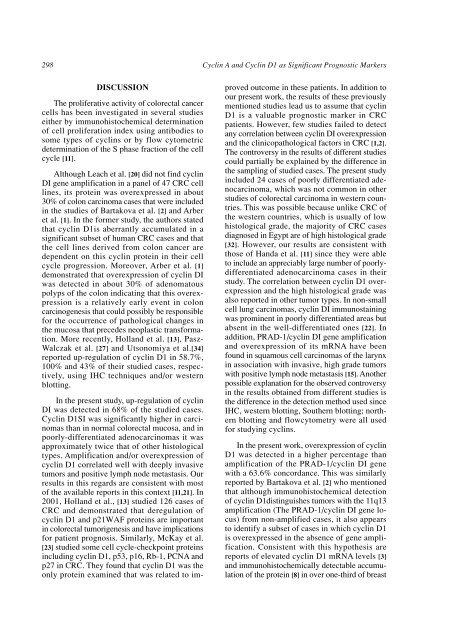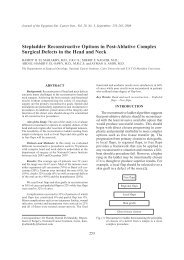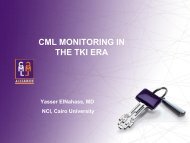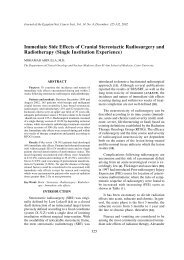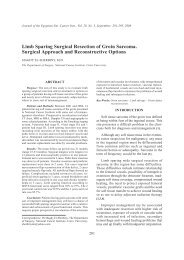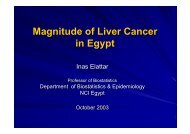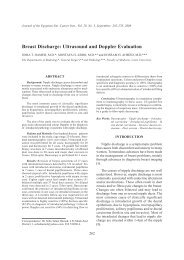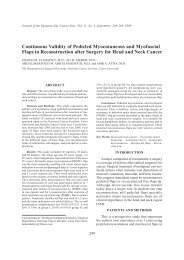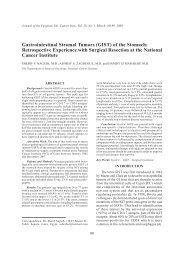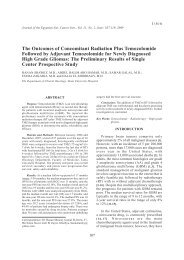Full text - PDF - The National Cancer Institute
Full text - PDF - The National Cancer Institute
Full text - PDF - The National Cancer Institute
You also want an ePaper? Increase the reach of your titles
YUMPU automatically turns print PDFs into web optimized ePapers that Google loves.
298Cyclin A and Cyclin D1 as Significant Prognostic MarkersDISCUSSION<strong>The</strong> proliferative activity of colorectal cancercells has been investigated in several studieseither by immunohistochemical determinationof cell proliferation index using antibodies tosome types of cyclins or by flow cytometricdetermination of the S phase fraction of the cellcycle [11].Although Leach et al. [20] did not find cyclinDI gene amplification in a panel of 47 CRC celllines, its protein was overexpressed in about30% of colon carcinoma cases that were includedin the studies of Bartakova et al. [2] and Arberet al. [1]. In the former study, the authors statedthat cyclin D1is aberrantly accumulated in asignificant subset of human CRC cases and thatthe cell lines derived from colon cancer aredependent on this cyclin protein in their cellcycle progression. Moreover, Arber et al. [1]demonstrated that overexpression of cyclin DIwas detected in about 30% of adenomatouspolyps of the colon indicating that this overexpressionis a relatively early event in coloncarcinogenesis that could possibly be responsiblefor the occurrence of pathological changes inthe mucosa that precedes neoplastic transformation.More recently, Holland et al. [13], Pasz-Walczak et al. [27] and Utsonomiya et al.[34]reported up-regulation of cyclin D1 in 58.7%,100% and 43% of their studied cases, respectively,using IHC techniques and/or westernblotting.In the present study, up-regulation of cyclinDI was detected in 68% of the studied cases.Cyclin D1SI was significantly higher in carcinomasthan in normal colorectal mucosa, and inpoorly-differentiated adenocarcinomas it wasapproximately twice that of other histologicaltypes. Amplification and/or overexpression ofcyclin D1 correlated well with deeply invasivetumors and positive lymph node metastasis. Ourresults in this regards are consistent with mostof the available reports in this con<strong>text</strong> [11,21]. In2001, Holland et al., [13] studied 126 cases ofCRC and demonstrated that deregulation ofcyclin D1 and p21WAF proteins are importantin colorectal tumorigenesis and have implicationsfor patient prognosis. Similarly, McKay et al.[23] studied some cell cycle-checkpoint proteinsincluding cyclin D1, p53, p16, Rb-1, PCNA andp27 in CRC. <strong>The</strong>y found that cyclin D1 was theonly protein examined that was related to improvedoutcome in these patients. In addition toour present work, the results of these previouslymentioned studies lead us to assume that cyclinD1 is a valuable prognostic marker in CRCpatients. However, few studies failed to detectany correlation between cyclin DI overexpressionand the clinicopathological factors in CRC [1,2].<strong>The</strong> controversy in the results of different studiescould partially be explained by the difference inthe sampling of studied cases. <strong>The</strong> present studyincluded 24 cases of poorly differentiated adenocarcinoma,which was not common in otherstudies of colorectal carcinoma in western countries.This was possible because unlike CRC ofthe western countries, which is usually of lowhistological grade, the majority of CRC casesdiagnosed in Egypt are of high histological grade[32]. However, our results are consistent withthose of Handa et al. [11] since they were ableto include an appreciably large number of poorlydifferentiatedadenocarcinoma cases in theirstudy. <strong>The</strong> correlation between cyclin D1 overexpressionand the high histological grade wasalso reported in other tumor types. In non-smallcell lung carcinomas, cyclin DI immunostainingwas prominent in poorly differentiated areas butabsent in the well-differentiated ones [22]. Inaddition, PRAD-1/cyclin DI gene amplificationand overexpression of its mRNA have beenfound in squamous cell carcinomas of the larynxin association with invasive, high grade tumorswith positive lymph node metastasis [15]. Anotherpossible explanation for the observed controversyin the results obtained from different studies isthe difference in the detection method used sinceIHC, western blotting, Southern blotting; northernblotting and flowcytometry were all usedfor studying cyclins.In the present work, overexpression of cyclinD1 was detected in a higher percentage thanamplification of the PRAD-1/cyclin DI genewith a 63.6% concordance. This was similarlyreported by Bartakova et al. [2] who mentionedthat although immunohistochemical detectionof cyclin D1distinguishes tumors with the 11q13amplification (<strong>The</strong> PRAD-1/cyclin DI gene locus)from non-amplified cases, it also appearsto identify a subset of cases in which cyclin D1is overexpressed in the absence of gene amplification.Consistent with this hypothesis arereports of elevated cyclin D1 mRNA levels [3]and immunohistochemically detectable accumulationof the protein [8] in over one-third of breast


